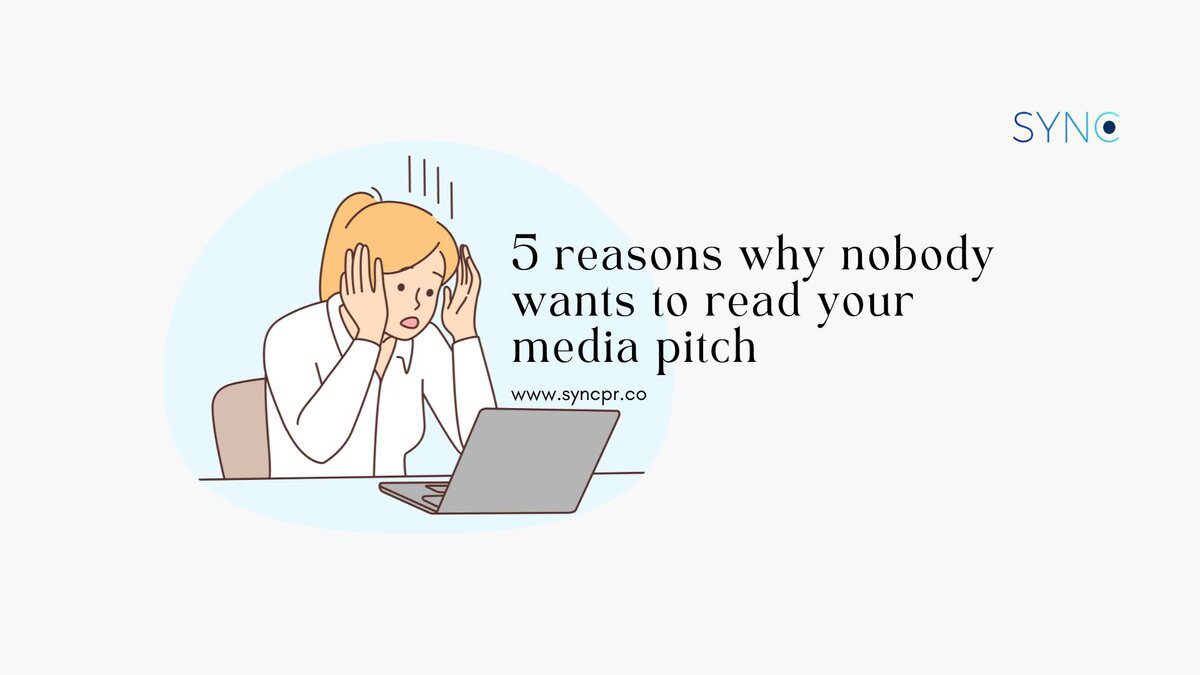Writing a media pitch may seem like a straightforward task. However, in reality, it is more maze-like than expected, as only 3 to 5 per cent of pitches are proven to be fruitful. The current circumstances in the media and communications industry are not in favour of PR either – with numerous media outlets letting go of a significant number of their writers while the PR industry grows in popularity and value – and there are now approximately 6 times more PR professionals for every journalist working in the industry. In other words, it’s harder to pitch to the media because of more competition with fewer journalists around. It is up to PR teams to put in the extra effort to pitch quality stories to the media.
Here are the 5 biggest mistakes people have made in the past you need to avoid when crafting and sending out a pitch.
Read Debunking myths: What PR is and isn’t
Not tailoring the media pitch to the journalists’ interests
One of the easiest mistakes to make when pitching something to the press is to opt for the easier route of mass pitching. Mass pitching saves a great deal of time for PR experts, and may not be wrong per se. However, it is regarded as a great faux pas in the industry as it blatantly ignores the journalists’ interests and wastes their time, which can negatively affect any rapport you may have built in the past.
To prevent this, you need to curate a list of relevant journalists who would be interested in the story you are pitching. If available, you can evaluate this through their past publications and what they are interested in based on their social media presence. It is essential to tailor the pitch so that you can express how the story can provide value to the journalists. Ask yourself the following questions:
- How does this story benefit the journalist and their publication?
- How does this story appeal to their target audience?
- How can this story contribute to the current discussions on the topic?
- Will this add more value to the ongoing discussion?
On top of that, you can also tie in their previous body of work into your pitch to show that you have done your research on how the story you are pitching is relevant to them. It is also an excellent way to develop a relationship and build trust with your media contacts over time.
Not taking timing into account before sending out the media pitch
Another rookie mistake is not taking timing and recent events into consideration when sending out your pitches. It is crucial to ensure the relevance of your pitch before you sit down to craft one, because you can either miss the perfect timing to pitch a relevant story, or you can come across as unconcerned about current events. PR professionals need to be in tune with daily affairs on the news as the window of opportunity to release a story can be very slim. On top of that, timing is critical as you need to be certain of the news activity right before sending a pitch – you want to avoid coming across as insensitive in the case of a national crisis or climate disaster that came without warning.
PR officers need to be more careful when preparing for a new round of media pitches. One of the best practices to ensure this is to conduct sufficient research on current topics and how they tie into your story. On top of that, remember to monitor the media within two days before you plan to send out a round of pitches to guarantee you did not miss anything important or out of the blue that may affect the media members’ reception of your pitch.
Read PR trends for startups in 2023
Using too much jargon, and not enough context in the media pitch
While incorporating jargon may be required to establish authority over a subject matter, it may not be the best course of action when pitching to the average journalist. While the journalists in your niche will appreciate the industry lingo, it would be in your best interest to try to write your pitch in layman’s terms and provide more context in the pitch when sharing it with a more general media outlet with a broader audience.

To achieve this, you need to break your media pitch down into smaller chunks of more understandable concepts using common terminologies. This way, your media contact will not have to spend time looking up the meaning of every other word just to understand your point. Besides that, it would not hurt your pitch to provide some context on why a niche issue would be of concern to the general public. Try to incorporate relevant and significant statistics into your pitch to help picture the gravity of the issue much clearer to a wider audience. This can help you reach more journalists and increase your chances of getting a story published by the media.
Not mastering the art of follow-ups
Did you know that journalists get an average of 50 pitches a week? In a sea of emails, it is easy for yours to get lost in your media contact’s inbox. Without an effective follow-up plan, you might miss the narrow window of opportunity to get your story published timely. Another common mistake during pitching is not swiftly following up on any show of interest or request for new information by the media. This could leave an impression on the journalist that you are not appreciative of their limited time and can result in the opportunity being passed. Hence, timely and appropriate follow-ups are crucial to getting your media pitch noticed.
It can be easy to assume that the solution to this would be the direct inverse, which is persistent follow-ups, but that would also be ill-advised. There is such a thing as too many follow-ups, which comes across as pushy and annoying. To combat these issues, you need to find a perfect balance of following up where you are quick to respond and prompt them appropriately. On top of that, if your media contact does not respond to your pitch after one to two follow-ups, you should move on and find other opportunities with other journalists.
Your media pitch sounds like a sales pitch
Finally, your media pitch may end up straight in the bin if it sounds too much like a sales pitch. Your job as a PR person may be to promote your client, but the journalists you reach out to do not share the same goal. They are inherently storytellers looking for something worth writing about. On top of that, a pitch that is too promotional will not bode well with the audience in general which will affect the journalist’s reputation. Hence, your pitch should not only be interesting to the journalist but should also keep their consumers in mind.
It is crucial that you craft your media pitch in a way that centres around a story or issue rather than a product or service. On top of that, you can also find an angle that piques the interests of the consumers while also being beneficial or informational for them. This way you establish authority over the knowledge and data, and in return can position your company or client as more trustworthy for the audience.
To put it simply, information is key to a successful pitch. Crafting a great media pitch requires careful consideration and extreme attention to detail. To reach the right people, you need to commit to finding out more information about and communicating better with your media contacts. If you would like to find out more about how SYNC can help your company get started in your PR campaign, reach out to us at [email protected]!

